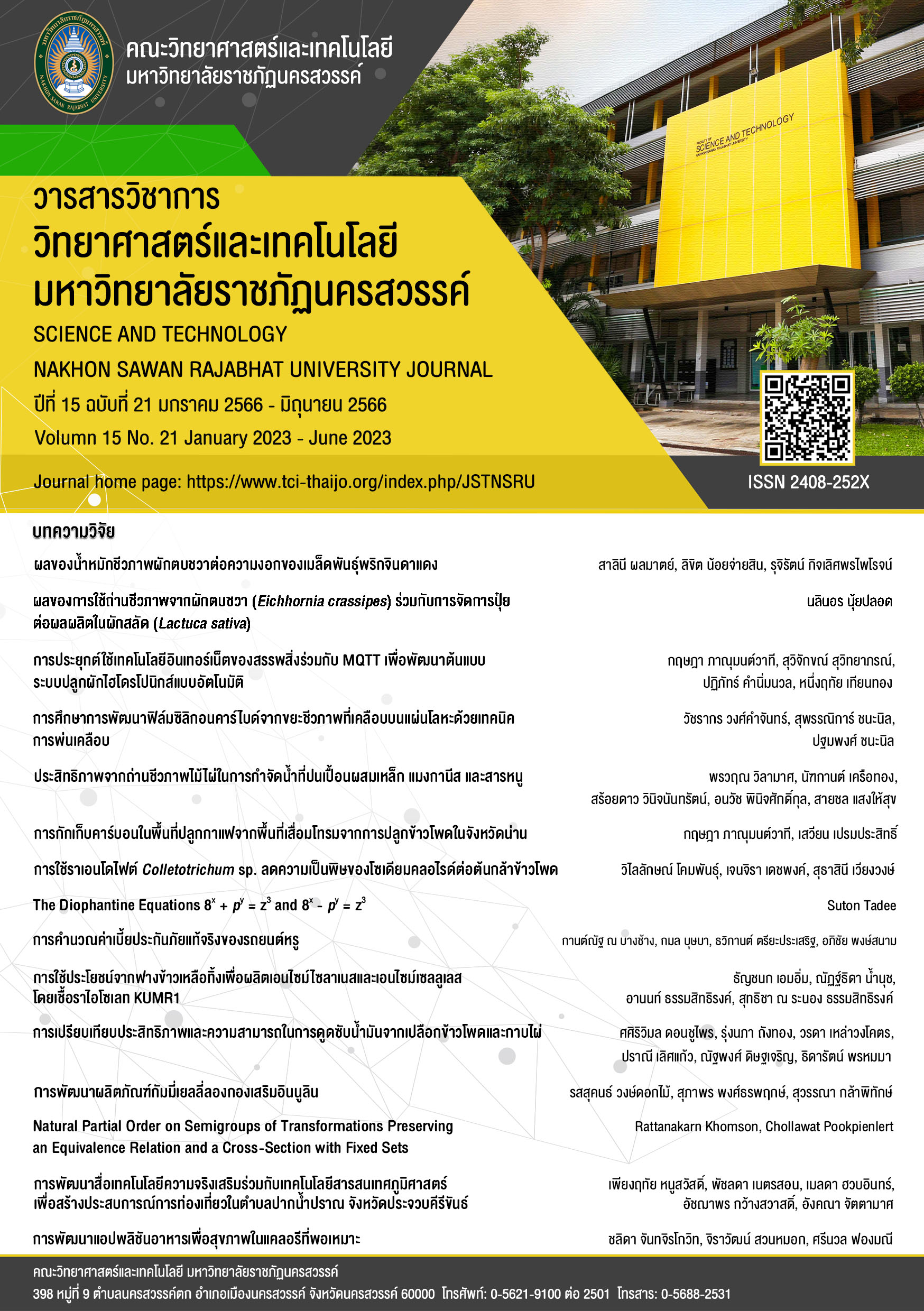การพัฒนาผลิตภัณฑ์กัมมี่เยลลี่ลองกองเสริมอินนูลิน
Main Article Content
Abstract
การวิจัยนี้มีวัตถุประสงค์เพื่อพัฒนาผลิตภัณฑ์กัมมี่เยลลี่ลองกองเสริมอินนูลิน โดยเริ่มต้นจากการศึกษาตำรับ กัมมี่เยลลี่ลองกอง โดยใช้ปริมาณเนื้อลองกองต่อน้ำ 3 อัตราส่วน ดังนี้ 100:0, 80:20, และ 60:40 จากนั้นนำไปทดสอบทางประสาทสัมผัสกับผู้เชี่ยวชาญ เลือกตำรับที่ดีที่สุดไปพัฒนาเป็นตำรับกัมมี่เยลลี่ลองกองเสริมอินนูลิน โดยใช้อินนูลิน 3 ระดับ คือ ร้อยละ 15, 20 และ 25 ของน้ำหนักเนื้อลองกอง นำไปทดสอบทางประสาทสัมผัสโดยผู้เชี่ยวชาญ จำนวน 5 คนและประเมินการยอมรับในผลิตภัณฑ์โดยบุคคลทั่วไป จำนวน 50 คน โดยใช้ 9-point hedonic scale และ 5-point hedonic scale ตามลำดับ วิเคราะห์สมบัติทางกายภาพและองค์ประกอบทางเคมีของผลิตภัณฑ์ และศึกษาอายุการเก็บของผลิตภัณฑ์ในบรรจุภัณฑ์ ผลการวิจัยพบว่าตำรับกัมมี่เยลลี่ลองกองที่อัตราส่วนเนื้อลองกองต่อน้ำเท่ากับ 100:0 ได้รับคะแนนความชอบจากผู้เชี่ยวชาญมากที่สุด (ค่าเฉลี่ย 7.20±1.10) เมื่อนำไปพัฒนาเป็นตำรับกัมมี่เยลลี่ลองกองเสริมอินนูลิน ตำรับเสริมอินนูลินร้อยละ 25 ได้รับคะแนนการยอมรับจากบุคคลทั่วไปสูงที่สุด (ค่าเฉลี่ย 4.26±0.75) มีคุณสมบัติทางกายภาพ ได้แก่ ค่า pH, aw, ค่าสี (L*,a*,b*) ค่าเนื้อสัมผัส (ความแข็ง ความเหนียว ความเคี้ยวได้) มีค่าเฉลี่ยไม่แตกต่างทางสถิติ (p≥0.05) และมีคุณค่าทางโภชนาการต่อ 100 กรัม ได้แก่ พลังงาน คาร์โบไฮเดรต ไขมัน และความชื้น ไม่แตกต่างจากตำรับที่ไม่เสริมอินนูลิน ยกเว้นฟรุกแทนซึ่งเป็นใยอาหารที่มีโครงสร้างเป็นพอลิเมอร์ของน้ำตาล ฟรุกโตส ที่มีปริมาณมากกว่าตำรับที่ไม่เสริมอินนูลินถึงร้อยละ 11.25 เมื่อศึกษาอายุการเก็บรักษาในบรรจุภัณฑ์ถุงพลาสติกพอลิโพรพิลีนที่อุณหภูมิ 31 องศาเซลเซียส พบว่าสามารถเก็บได้เป็นระยะเวลา 21 วัน โดยมีปริมาณจุลินทรีย์ทั้งหมด ยีสต์และราเป็นไปตามเกณฑ์มาตรฐานผลิตภัณฑ์ชุมชนและมีการเปลี่ยนแปลงด้านกลิ่นและรสชาติเล็กน้อย
Article Details

This work is licensed under a Creative Commons Attribution-NonCommercial-NoDerivatives 4.0 International License.
References
โชคชัย ธีรกุลเกียรติ. (2016, ม.ป.ป.). สารสกัดธรรมชาติเพื่อใช้ยับยั้งการเกิดสีน้ำตาลในผักและผลไม้. โครงการวิจัยทุนอุดหนุนวิจัย มก. ภาควิชาวิทยาศาสตร์และเทคโนโลยีการอาหาร คณะอุตสาหกรรมเกษตร มหาวิทยาลัยเกษตรศาสตร์. https://www3.rdi.ku.ac.th
ภาสุรี ฤทธิเลิศและกมลวรรณ วารินทร์. (2019). การพัฒนาผลิตภัณฑ์กัมมี่เยลลี่มะม่วงหาวมะนาวโห่. Development of Karanda (Carissa carandasL.) Gummy Jelly Product. Thai Journal of Science and Technolog, 9(2), 342-354. https://doi.org/10.14456/tjst.2020.45
รวีพร ศรีสำราญ ฉวีวรรณ พันธ์ไชยศรี ธเนศ แก้วกําเนิด และวิจิตรา แดงปรก. (2553). ผลของการเติมอินูลินต่อคุณภาพและทางประสาทสัมผัสของไส้กรอกไก่ไขมันต่ำ. คณะวิศวกรรมและอุตสาหกรรมเกษตร, มหาวิทยาลัยแม่โจ้.
สำนักงานมาตรฐานผลิตภัณฑ์อุตสาหกรรม, (2547). มาตรฐานผลิตภัณฑ์ชุมชนเยลลี่แห้ง. มผช. 520-2547, กรุงเทพฯ.
สำนักงานมาตรฐานสินค้าเกษตรและอาหารแห่งชาติ. (2559). ข้อมูลการบริโภคอาหารของประเทศไทย. สำนักกำหนดมาตรฐาน.
Akbari, M., Eskandari, M. H., Niakosari, M., & Bedeltavana, A. (2016). The effect of inulin on the physicochemical properties and sensory attributes of low-fat ice cream. International Dairy Journal, 57, 52-55. https://doi.org/10.1016/j.idairyj.2016.02.040
Allahvaisi, S. (2012). Polypropylene in the industry of food packaging. ISSBN. 978-953-51-06-36-4
AOAC. (2019). Offcial Methods of Analysis of AOAC International 2019.
Bogha, T., Sawate, A., Kshirsagar, R., Agarkar, B., & Patil, B. (2020). Studies on development and organoleptic evaluation of blended guava-pineapple jelly incorporated with Aloe vera. Journal of Pharmacognosy and Phytochemistry, 9(1), 1969-1972.
Brasil, J. A., Silveira, K. C. d., Salgado, S. M., Livera, A. V. S., Faro, Z. P. d., & Guerra, N. B. (2011). Effect of the addition of inulin on the nutritional, physical and sensory parameters of bread. Brazilian Journal of Pharmaceutical Sciences, 47, 185-191.
Capriles, V. D., & Arêas, J. A. (2013). Effects of prebiotic inulin-type fructans on structure, quality, sensory acceptance and glycemic response of gluten-free breads. Food & Function, 4(1), 104-110.
Delgado, P., & Bañón, S. (2018). Effects of replacing starch by inulin on the physicochemical, texture and sensory characteristics of gummy jellies. CyTA-Journal of Food, 16(1), 1-10. https://doi.org/10.1080/19476337.2017.1327462
Hashemi, M., Gheisari, H. R., & Shekarforoush, S. (2015). Preparation and evaluation of low‐calorie functional ice cream containing inulin, lactulose and Bifidobacterium lactis. International Journal of Dairy Technology, 68(2), 183-189. https://doi.org/10.1111/1471-0307.12173
Helal, A., Rashid, N., Dyab, M., Otaibi, M., & Alnemr, T. (2018). Enhanced functional, sensory, microbial and texture properties of low-fat set yogurt supplemented with high-density inulin. Journal of Food Processing & Beverages, 6(1), 01-11.
Khuenpet, K., Jittanit, W., Sirisansaneeyakul, S., & Srichamnong, W. (2017). Inulin powder production from Jerusalem artichoke (Helianthus tuberosus L.) tuber powder and its application to commercial food products. Journal of Food Processing and Preservation, 41(4), e13097. https://doi.org/10.1111/jfpp.13097
Kim, Y., Faqih, M., & Wang, S. (2001). Factors affecting gel formation of inulin. Carbohydrate polymers, 46(2), 135-145. https://doi.org/10.1016/S0144-8617(00)00296-4
Luisa García, M., Cáceres, E., & Dolores Selgas, M. (2006). Effect of inulin on the textural and sensory properties of mortadella, a Spanish cooked meat product. International journal of food science & technology, 41(10), 1207-1215. https://doi.org/10.1111/j.1365-2621.2006.01186.x
Niness, K. R. (1999). Inulin and oligofructose: what are they? The Journal of nutrition, 129(7), 1402S-1406S. https://doi.org/10.1093/jn/129.7.1402S
Periche, A., Heredia, A., Escriche, I., Andrés, A., & Castelló, M. (2014). Optical, mechanical and sensory properties of based-isomaltulose gummy confections. Food Bioscience, 7, 37-44. https://doi.org/10.1016/j.fbio.2014.05.006
Shoaib, M., Shehzad, A., Omar, M., Rakha, A., Raza, H., Sharif, H. R., Shakeel, A., Ansari, A., & Niazi, S. (2016). Inulin: Properties, health benefits and food applications. Carbohydrate polymers, 147, 444-454. https://doi.org/10.1016/j.carbpol.2016.04.020
Takeungwongtrakul, S., Thavarang, P., & Sai-Ut, S. (2020). Development of Strawberry gummy jelly with reduced sugar content from strawberry syrup. International Journal of Agricultural Technology, 16(5), 1267-1276.
Tapia, M. S., Alzamora, S. M., & Chirife, J. (2020). Effects of water activity (aw) on microbial stability as a hurdle in food preservation. Water activity in foods: Fundamentals and applications, 323-355. https://doi.org/10.1002/9781118765982.ch14
Wang, X., Wang, T., Zhang, Q., Xu, L., & Xiao, X. (2021). Dietary supplementation with inulin modulates the gut microbiota and improves insulin sensitivity in prediabetes. International journal of endocrinology, 2021. https://doi.org/10.1155/2021/5579369
Zainol, M., Cheang, L., Zuraidah, N., Yahya, F., & Zin, Z. (2021). Storage stability of sweet corn (Zea mays var saccharata Bailey) jam: effect of sugar to inulin ratios on physicochemical, ascorbic acid, β-carotene and sensory characteristics. IOP Conference Series: Earth and Environmental Science. https://doi.org/10.1088/1755-1315/756/1/012074


